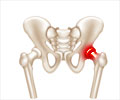Women aged 65 and older are routinely screened for osteoporosis using bone mineral density (BMD) screening following recommendations

Now a new study led by Margaret L. Gourlay, MD, MPH of the University of North Carolina at Chapel Hill School of Medicine finds that women aged 67 years and older with normal bone mineral density scores may not need screening again for 15 years.
"If a woman''s bone density at age 67 is very good, then she doesn''t need to be re-screened in two years or three years, because we''re not likely to see much change," Gourlay said. "Our study found it would take about 15 years for 10 percent of women in the highest bone density ranges to develop osteoporosis."
"That was longer than we expected, and it''s great news for this group of women," Gourlay said.
Gourlay, an assistant professor in UNC''s Department of Family Medicine, presented these results in a study published in the Jan. 19, 2012 issue of The New England Journal of Medicine.
In the study, Gourlay and study co-authors analyzed data from 4,957 women aged 67 years and older that were collected as part of the longest-running osteoporosis study in the U.S., the Study of Osteoporotic Fractures. These women were enrolled in the study from 1986 to 1988 when they were 65 years or older, and had bone mineral density (BMD) testing starting about two years later. All had bone mineral density testing at least twice during the study period; some were tested up to five times over a period of 15 years.
Advertisement
The researchers calculated estimated times for 10 percent of the women in each T-score group to transition to osteoporosis. For the high risk group, the estimated time was 1.1 years, while it was about 5 years for the moderate risk group and slightly over 15 years for the low risk group. They found that in those same time periods, only 2 percent or less of women had hip or clinical vertebral fractures, which are the most important fractures doctors try to prevent by screening for osteoporosis.
Advertisement
Co-authors of the study are Jason P. Fine, ScD and John S. Preisser, PhD, both research professors of biostatistics; Ryan C. May, MS, formerly a doctoral student in the UNC Gillings School of Global Public Health; Chenxi Li, PhD, postdoctoral associate in the North Carolina Translational and Clinical Sciences Institute; David F. Ransohoff, professor of medicine; Li-Yung Lui, MA, MS of the California Pacific Medical Center Research Institute, Jane A. Cauley of the University of Pittsburgh, and Kristine E. Ensrud, MD, MPH of the Minneapolis Veterans Affairs Health Care System and the University of Minnesota.
Source-Newswise















